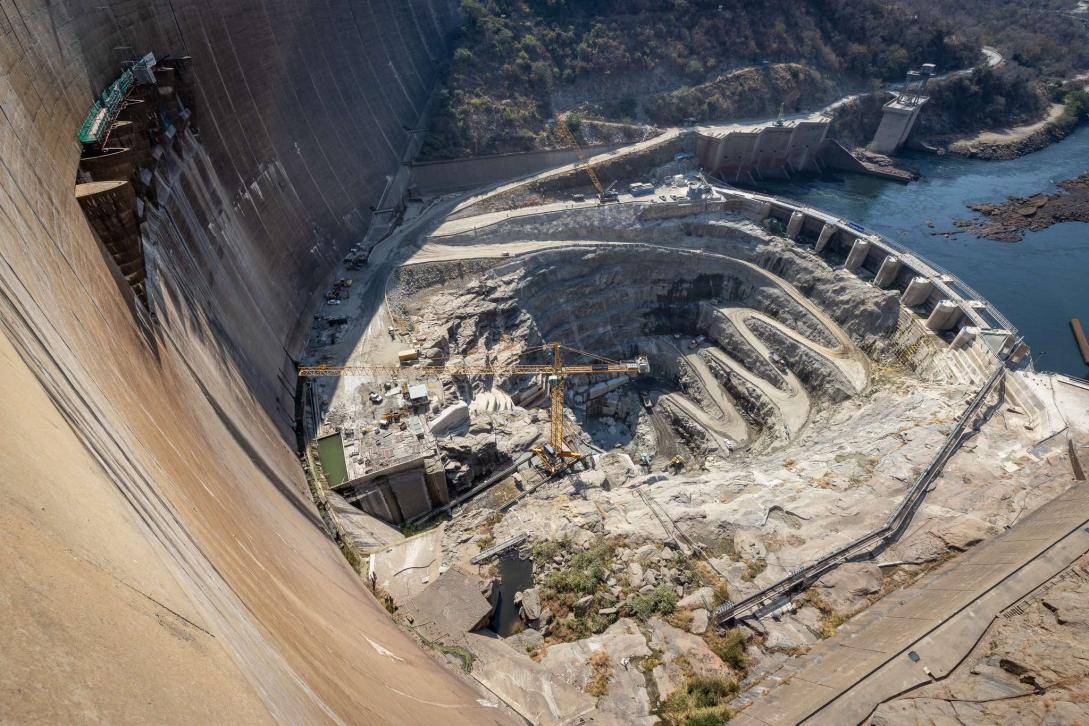Kariba Dam Rehabilitation Project (KDRP)

Kariba Dam is a concrete arch dam, standing 128 meters tall with a crest length of 617 meters, built across the Zambezi River between Zambia and Zimbabwe. Constructed between 1956 and 1959, the dam created Lake Kariba, the largest man-made lake in the world by reservoir storage capacity, holding 181 cubic kilometers of water. It plays a crucial role in regional energy security and economic development, providing Zambia and Zimbabwe with 2,130 MW of power generation capacity and having the potential to produce over 10,000 GWh of clean, renewable energy annually.
Over time, the force of water cascading from the sluice gates has gradually eroded the natural rock floor, forming a plunge pool downstream of the dam that reaches a depth of approximately 80 meters. To manage its continued evolution and prevent weakening of the dam's foundation, the optimal solution involves enlarging the plunge pool, primarily downstream but also extending towards both banks, and safeguarding the dam's downstream toe with a concrete lining. This reshaping will enhance the efficient discharge of spillage flows downstream, preventing the concentration of turbulence in a restricted and confined area and thereby mitigating erosion. These are the first works of this kind in the world.
In addition to reshaping the plunge pool, there is an urgent need to rehabilitate the six sluice gates that make up the spillway. Over the past 60 years, concrete expansion due to natural chemical reactions has affected the smooth operation of these gates. A properly functioning spillway is crucial for maintaining the reservoir at optimal levels in accordance with the Zambezi River's flood regime.
The Kariba Dam Rehabilitation Project has reached a significant milestone in 2024 with the successful completion of the excavation and concreting works, including the construction and refilling of the plunge pool. This marks the near completion of the EU-funded part of the project (Component 2 - more details under the Funding section below). The entire project is scheduled to be completed by the end of 2025, with the plunge pool reshaping works (Component 2) being finalised when the cofferdam stop logs are removed in September or October 2024.
Upon completion of the works, the Kariba Dam will achieve enhanced stability and operational reliability, significantly reducing the risk of potential failure. The consequences of a dam collapse would be catastrophic, potentially resulting in over 500,000 fatalities, affecting nearly 3 million people, and causing an economic impact exceeding USD 20 billion. It would impact not only Zambia and Zimbabwe, but also Malawi and Mozambique.
Funding
KDRP is co-financed by the EU, World Bank (WB), African Development Bank (AfDB), Swedish International Development Cooperation Agency (SIDA), and Zambia Revenue Authority (ZRA). The project comprises three distinct components, each funded by different co-financing partners:
- Component 1: Institutional support (providing engineering services for Components 2 and 3) – funded by WB, AfDB, SIDA, and ZRA
- Component 2: Plunge pool reshaping – funded by the EU
- Component 3: Refurbishment of the spillway – funded by WB, AfDB, and SIDA
The plunge pool reshaping works are supported by the EU, with EUR 83.5 million from the European Development Fund (EDF) and EUR 30 million from the Neighborhood, Development and International Cooperation Instrument (NDICI).
Objectives
The Overall Objective of KDRP is to enhance the reliability of energy supply and promote clean energy in Zambia and Zimbabwe while reducing the risk of dam failure.
The Specific Objective (Outcome) of this initiative is to assist the Zambezi River Authority (ZRA) in rehabilitating the Kariba Dam by stabilising its plunge pool and refurbishing its spillway to meet international safety standards.
This action will yield two main outputs: first, the stabilisation of the plunge pool downstream of the dam wall; second, the refurbishment of the spillway system.
The primary activities for achieving the First Output (EU funded Component 2) involve reshaping the plunge pool and include:
- Construction of access roads
- Construction of a cofferdam in concrete and metallic structure
- Construction of a grout curtain below the cofferdam
- Installation of monitoring instrumentation
- Reshaping the plunge pool in the dry through excavation of 300,000 m³ of rock using the drill and blast method and removal of spoils to designated dumpsite
- Construction of a concrete fault protection slab and related works
A contract with Razel-Bec was awarded in 2017, and completion of these works is scheduled for October 2024.
For the Second Output (funded by WB, AfDB, and SIDA under Component 3), the main works involve replacing the six spillgates. These include installing a cofferdam for each sluice gate, hydrodemolition, and installing built-in parts.
The consortium General Electric-Freyssinet is responsible for executing this Component, with works starting in 2019 and expected completion by the end of 2025.
Gruner-Stucky is providing the necessary engineering services to support the implementation of these works.
Results
Upon completion, the programme will have successfully stabilised the plunge pool downstream of the dam wall and refurbished the spillway system, bringing the dam into alignment with international safety standards and significantly reducing the risk of dam failure.
Under the EU-funded component of the programme, focused on plunge pool reshaping, three significant milestones have already been accomplished: the completion of the cofferdam in June 2022, the completion of excavation works in December 2023, and the completion of the concreting works and the beginning of the refilling of the plunge pool in July 2024.


